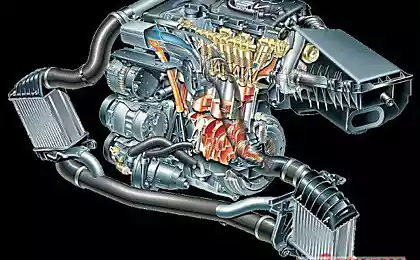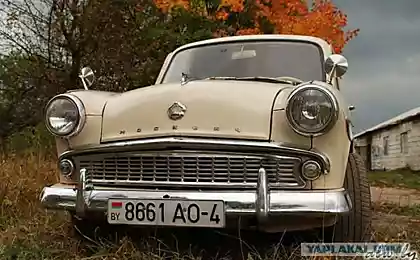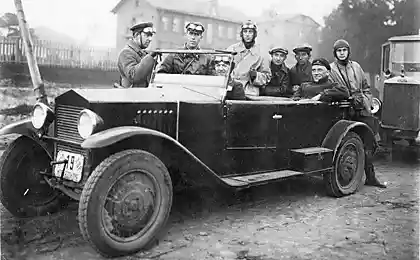402
The history of the legendary "Gelendwagen"
Mercedes Gelandewagen, conceived as a utilitarian SUV, a carrier of soldiers, for 36 years of its glorious history has turned into a real Rolls-Royce among all-terrain vehicles. And its simple functional design, which was once accused of a kind of worker-peasant primitiveness, is now called only classical.
The date of birth of the car was officially announced on February 10, 1979. On this day, a new car was presented to the public for the first time and the production line was launched. But 1979 is only a conditional date, a symbol. The history of the Mercedes-Benz G-Class began much earlier.
Gelendwagen is a living legend of the SUV world. This car is in the garage of the Pope and in the fleet of the President of Russia. But, few people know that the history of Gelandewagen (translated from the German “off-road car”), began in 1926, when the experimental Mercedes-Benz G1 was created, equipped with a second rear axle, designed to improve the cross-country performance of the car.
The G1 prototype and subsequent modifications of the G2 and G3 did not go into the series: the production of Mercedes-Benz SUVs began only in 1934, when the small-scale assembly of the G4 model was organized. This six-meter three-axle car, equipped with engines from sports models Mercedes-Benz 500K and 540K (but without a compressor), was used by the top of the Third Reich.
For three years, only 57 copies of the Mercedes-Benz G4 were collected, after which the company launched a new version of the SUV - the army model G5.
This seemingly unremarkable car with a small body and a weak engine had one unique feature: the rear axle wheel rotation system. That is, the G5 was not only all-wheel drive, but also all-wheel drive, which provided it with fantastic maneuverability.
The last model was produced from 1937 to 1941 and sold in the amount of 378 copies, but in fame it was much inferior to the giant Mercedes-Benz G4.
The recent history of Gelandewagen dates back to 1972, when the Austrian company Steyr-Daimler-Puch AG, as part of a joint project with Mercedes-Benz, began work on an SUV codenamed H2. According to the specification, launched by the marketing department of Mercedes-Benz in the design bureau Steyr-Daimler-Puch AG, it was supposed to be a universal car, equally suitable for military needs and for use by private owners.
The Austrians worked quickly: a full-size model of the SUV, made in the old-fashioned way from wood, was ready by the spring of 1973, and a year later, running tests of the prototype of the future Gelandewagen began.
However, it is not known how the future fate of this model would have developed if exactly 40 years ago, in 1975, a landmark event had not occurred that gave a new impetus to the work on the project.
It was then that Daimler-Benz agreed with Steyr-Daimler-Puch (Austria) to jointly produce SUVs. The choice of place and partner was not accidental. First, it was originally planned to produce a relatively small series of cars - about 10 thousand per year. Loading production facilities in Germany for the sake of this amount made no sense. Secondly, Steyr by that time boasted extensive experience in the design and production of all-wheel drive technology. With its conveyors already descended cars car layout – Pinzgauer and Haflinger, created by a team of engineers under the leadership of Erich Ledvinka – the son of the legendary engineer Hans Ledvinka, who worked for Tatra for a long time.
It is not surprising that the design of the future joint SUV was entrusted to Ledvinka. The first prototype H2 (i.e. Haflinger 2) with a gasoline engine and a transmission from the passenger Mercedes-Benz was ready in record time. Since the car was designed primarily as an army, the body was emphasized in a simplified form, with flat panels and a folding windshield for an open model. To distinguish the prototype H2 from the future production Geländewagen could only be simplified front. The famous grille with recessed round headlights will appear only in 1976 on the prototype Expedition.
The design of the H2, especially when compared to other creations of Erich Landvinka, looked very conservative. The usual staircase frame, lever-spring dependent suspension of all wheels, disc brakes in the front, drum brakes in the rear. Naturally, with an amplifier. At the same time, the future off-road star could boast a permanent all-wheel drive with locks of the central and rear differentials. And no ridge frames like the Steyr SUVs, steerable rear wheels and fully independent suspension like the pre-war Mercedes-Benz G5.
Already in 1974, prototypes began to wind kilometers through the most severe places: on the Steyr-Daimler-Puch mountain range - the Schöckl highway near Graz, in the coal mine, in Scandinavia beyond the Arctic Circle, in the sandy and rocky deserts of North Africa, on the Arabian Peninsula, and also on the off-road of Argentina.
No one was in a hurry to launch the series. A serious incentive for the project was a large order for 20 thousand cars for the Iranian army. In February 1977, Daimler-Benz AG together with Steyr-Daimler-Puch AG created a joint venture GFG (Geländefahrzeug-Gesellschaft). Production was decided to start at the plant in Graz, owned by Steyr-Daimler-Puch.
Under the terms of the contract, Germany did the engine, transmission, bridges, steering and large body parts. For the stamped parts of smaller size, as well as the transfer case, the Austrians were responsible. The terms of the distribution markets were interesting. Most of the all-terrain vehicles produced were supposed to wear a Mercedes-Benz star on a grille, and only 10% of the total production was sold under the Puch brand. Under the terms of the agreement, their implementation was allowed only in Austria, Switzerland, as well as in Eastern Europe.
About the Gelendwagen is often said that it was created by order of the Bundeswehr - hence its solidity, endurance and reliability. But the truth was that the market was originally the civilian sector, not the military. In the seventies, the Bundeswehr, however, planned to purchase new all-wheel drive cars, but concluded an agreement with the governments of France and Italy regarding the general development under the working title "European Jeep". According to the specifications, the vehicle was supposed to be floating, and the Geländewagen did not meet the expectations of the German military. However, this project closed in 1976 and the Bundeswehr announced a tender for the supply of 8800 units of SUVs, missing the buoyancy requirement. Daimler-Benz put up a prototype of its all-terrain vehicle for competition, but for some reasons the army chose the Volkswagen VW 183, better known as the Iltis.
The choice of the Bundeswehr was driven primarily by delivery dates - Volkswagen announced that the first cars would be delivered before the end of 1978 - as well as the price. Daimler-Benz was defeated. In 1976, the Geländewagen was still a prototype that had to be modified and improved. In addition, the choice was motivated by political motives - in the previous tender, the Bundeswehr had already signed a contract for the supply of Unimog, and the refusal at that time to state-owned Volkswagen would have meant giving full advantage to Daimler-Benz.
There is no doubt that interest in the car on the part of the army awakened the ambitions of Daimler managers. The analysis of the civilian market was not very optimistic and the return on production could only guarantee a large order of a country for its army. When in 1976 Geländewagen participated in the tender of the Bundeswehr, the decision on its future was already decided - analysts stated that the products will be profitable.
Already in 1978, a pre-production model with a soft quick-removal top was ready, which was now called the Geländewagen (i.e., a cross-country car). However, the new Iranian government, which came to power in 1979 after the famous Islamic revolution, canceled such an important order. The German army, on which the partners had high hopes, showed no interest in the new machine. Fortunately, the situation improved somewhat at the expense of the border guards of Germany, as well as the armies of Argentina and Norway.
How did Geländewagen overcome all these difficulties? To a large extent, we can say that the case.
In the seventies, one of the main customers of Daimler was the Iranian royal family. The ambitious Shah Reza Pahlawi wanted to make his country the third military power after the United States and the USSR. With huge revenues from oil exports, he could afford it. One of the ideas behind the dream was to buy 20,000 all-wheel drive cars for the Iranian army. In 1975, Mercedes received such an order.
It was like a wind in sail after a complete calm. In February 1977, Daimler-Benz AG together with Steyr-Daimler-Puch AG formed an alliance called GFG (Geländefahrzeug-Gesellschaft), in which both companies contributed half of the contributions. The new company was called upon to develop, implement and further improve the design of the Geländewagen, as well as promote sales of the model. The engine, transmission, axles were to be produced by Daimler, and the transfer case Steyr-Daimler-Puch. Everything else could be supplied by other companies. The products were planned to be produced at the plant in Graz, owned by 100% Steyr-Daimler-Puch.
One of the conditions between the partners was the division of the market. In the domestic market of Steyr in Austria, Switzerland, as well as the countries of the then "Eastern bloc", including Poland, Geländewagen was sold under the brand name PUCH. In other countries, the car was sold under the Mercedes-Benz brand. Accordingly, in the first case on the grille adorned the emblem "PUCH", and the rest - "Mercedes".
The laying of stones for the construction of the installation pavilion Geländewagen in Graz.
On March 11, 1977, Austrian Chancellor Bruno Kreisky personally laid the stones for the construction of a new pavilion of Steyr-Daimler-Puch AG enterprises in Graz-Thondorf, whose area exceeded 40,000 square meters. The GFG took full control of the project in late 1978, but a few months later, Reza Pahlawi imposed martial law on Iran. In mid-January, the Islamic Revolution forced him to flee the country. It became clear that the order for 20,000 cars disappeared with him, but the flywheel production was not stopped.
Although Mercedes-Benz managers did not have too many reasons to cheer, the premiere of Geländewagen was crowned with success. Journalists spoke about the new car, if not enthusiastically, then positively.
The Mercedes-Benz G-class assembly line was launched in Pavilion No. 12 of the Graz plant on February 1, 1979, and the first presentations of the W460 car to the public followed from February 5 to 10, 1979. Also for the press near Marseille in the southern part of France in Le Castellet were shown four models in two versions - short base and long base, as well as five body options. Two of them - 230G and 280G were equipped with gasoline engines, and the other two - 240GD and 300GD - diesel. All cars were equipped with a four-speed manual gearbox and a connected front-wheel drive. Depending on preferences, the buyer could choose a short-base convertible covered with a tarp, or a short-base or long-base closed version. For the military, it was possible to order a long-base model of both three-door and five-door versions covered with a tarp. The color palette was limited to five shades: white cream (Crèmeweiß), yellow wheat (Weizengelb), beige (Coloradobeige), red (Karminrot), and green (Agavengrün).
But most of all, the Mercedes G-class distinguished itself from other models - connecting the front-wheel drive without the need to stop. The same applies to the differential locking system. At the premiere, it was announced that in the near future the G-class will be available with a four-speed automatic transmission. In the future, it will be shown that the start of serial production will give only a small respite to managers and engineers involved in the project “Geländewagen”.
Within a short time after the debut of the Mercedes G-class, the market gave the car its own rating. And she was not as enthusiastic as the first reviews from journalists invited to France.
No one disputed the unique all-terrain properties of the Geländewagen, which feels comfortable both on the track and on rough terrain. It was early to assess the endurance of the design, but the solutions used in the form of a steel frame with a body fixed on it, bridges and a transfer case, it would seem, guaranteed reliability. In addition, the designers of the car revealed that for five years, the prototypes of the Mercedes G-class were subjected to killer tests, held at the Steyr-Daimler-Puch test site, the Schöckl highway near Graz, in the gorge of the quarry between Kolonią and Aachen, in Scandinavia beyond the Arctic Circle, the sandy and rocky deserts of North Africa, the Arabian Peninsula, and off-road Argentina.
Disturbing calls were made about the quality of the individual equipment. The project management was aware of a number of systematic problems, but the problem lay mainly on the part suppliers who were unable to deliver the ordered parts according to the quality specification of Mercedes-Benz.
The market has developed the basic principles of positioning the Mercedes-Benz G-Class. The Geländewagen was not meant to be a simple reliable vehicle and a convenient all-wheel drive car. The task, which was entrusted to the designers, was complicated: it was necessary to build a car with capabilities not met before. On the one hand, it was to be characterized by reliability and endurance in different geographical conditions – to meet the expectations of forest services, agriculture, energy, military; on the other hand, it should be a convenient, well-equipped and, most importantly, a safe vehicle. The most interesting thing is that such a car was built with the difference that it was difficult to satisfy two opposite groups of buyers at once.
In 1979, the production capacity of Graz was 10,000 all-terrain vehicles per year, with 1,000, 5,500 and 6,000 cars leaving the plant in the first three years, respectively. These figures were underestimated, because in the first year, 2,801 were produced, and in the subsequent years, respectively, 7,533 and 6,950 pieces. Overfulfillment of production plans was provided by the orders of the German services - the border troops and the local police. The lost Bundeswehr tender was fully compensated. A few sold to Argentina returned to Europe as English trophies after the Falklands War ended in 1982.
A strategic mistake was soon discovered. Instead of the short-wheelbase model with an open body, which was put by the leadership of Daimler, the long-wheelbase closed W460 was the most popular. To cope with the flow of orders, it took a rapid change in priorities - adjusting business plans and spare parts orders from suppliers. The unfortunate consequences of the error were dozens of already made, but not sold convertibles.
Planning errors due to unrecognized market needs and expectations also affected the interiors of the vehicle, additional equipment, and the engine. In the future, it will become clear that the error stretches from specialists to whom the parameters of driver and passenger comfort seemed more important than engine power. Of the four types of engines presented to the Mercedes-Benz G-class market, weak ninety-strong 2.3-liter bezin engines were produced in large circulation, as well as 2.4-liter diesel models. Buyers were looking for Mercedes with a gasoline engine of 2.8 liters (150 hp), as well as three-liter diesel models with a capacity of 88 hp.
In the 1979 advertising booklets, the name of the model with a 2.8 liter engine indicated the letter “E”, indicating electronic injection. Until the end of 1981, there were no spare parts available. Mercedes suffered from a shortage of M110 engines at the time. In fact, their distribution began only in the second half of the 80s, when the 280 GE model went on sale.
Making minor changes to the appearance and equipment of the car has become a regular feature that accompanies the G-Class to the present day. If in 1979 the military complained about too low power engines, private customers complained of too Spartan internal appearance, lack of automatic transmission, air conditioning, as well as a small range of body colors. It was these comments of customers that led, after a short respite, which arose due to the launch of a series of new products, to the continuation of the work of designers. The first changes to the G-class occurred in the second half of 1981. Now it was possible to order a car with automatic transmission, a mechanical winch, increased by 16 liters of fuel tank. The long-base version offered side benches in the trunk. In the spring of 1982, Geländewagen received the steering wheel from the W123 model, and the gasoline versions of the G230 and G280 waited for the installation of electronic injection, which led to both the removal of restrictions on sales of the 280 GE and the start of production of the 230 GE model. The M102 engine used in the E 230 in the W123 and W124 series replaced the M115 carburetor engine installed on the 230 G since 1979. However, production of the latter was not completed; it was withdrawn from offers for Germany, Austria and Switzerland, but for other countries it was delivered until mid-1986.
In response to the wishes of potential buyers, new improvements to the G-Class were made in 1983. First of all, this affected the expansion of the range of colors - now 4 additional metallic colors were offered to choose from. In addition, the mechanical gearbox has moved into the category of options. In the fall of 1983, a new light switch was added, and the keys including fans were replaced by a rotary handle. The third face lift took place in September 1985.
The standard was the installation of mechanical locks of differentials on both axles and a reinforced front bumper equipped with a system for towing the car. Inside there was a new upholstery of seats, back sofa, ceiling and doors. Newly located pointers on the dashboard. As an option, a central lock appeared, as well as rubber expanders that hide the installation of non-standard tires if necessary.
In September 1987, the 240 GD was replaced by a 250 GD with a manual transmission, and the remaining models were subjected to the fourth face lift. The most significant change was the installation of a steel gas tank, the capacity of which was increased from 70 to 81.5 liters. Now you could order a G-class with electric windows and even a retractable antenna.
Initially, the business plan of the project “Geländewagen” assumed that the car will be produced within 10 years. In July 1986, a 50,000th car was built, and the following year the question arose what to do next. Within eight years, on the one hand, the design of the car was refined, on the other hand, it was obvious that further improvements and investments were needed. If ten years earlier, the idea of a car that was equally in demand by the military and families with children had any justification, now it seemed completely meaningless. People using the car daily needed more comfortable seats, air conditioning, a more solid dashboard and a stereo system. The rapidly growing segment of civilian buyers expected significant changes in comfort that were already available in other passenger cars.
In these circumstances, a new decision to modernize the G-Class followed, namely the creation of a new model focused exclusively on civilians. The line with the index W463 was designed to offer comfort on a par with other passenger models, using ready-made solutions. As with the W460, the W463 project was shrouded in mystery. This time the work was entrusted to the Stuttgart passenger car department.
The new G-class was unveiled during the IAA exhibition in Frankfurt in September 1989. The car made a splash. Outside, it differed only in some details - a plastic grille, side mirrors, a new front bumper with built-in fog lights, a rear bumper with PTF, enlarged taillights, an exhaust pipe moved to the left side and a fuel tank placed on the right. Very revolutionary changes have occurred with the interior. It was a completely different car – a redesigned dashboard and center console, air conditioning, leather interior, elegant seats, audio system and finally an electric roof. The range of additional options has been significantly expanded. The new model was also equipped with an airbag and ABS, which is the standard for passenger cars.
When designing it turned out that for the correct operation of the ABS, it was necessary to change the type of drive - now the W463 is characterized by a permanent four-wheel drive with a central center differential locking. Constructive changes also affected the frame and bridges. Similar to the W460 series, the G-class W463 series was equipped with differential locks, with the difference that they were now switched on by a button on the center console.
At the start of sales of the W463 interested buyer had a choice of four models - two petrol: 230 GE (126 hp) and 300 GE (177 hp) and two diesel: 250 GD (94 hp) and 300 GD (113 hp). All of them were equipped with a four-speed automatic transmission, although optionally you could order a manual gearbox.
Already in the first months of sales, the Mercedes G-class used solutions that have survived to this day. The desire of Daimler’s managers to satisfy two different customer groups resulted in several years of work, but in the end found a happy ending.
The result of a bright advertising campaign of the new W463 series was a decline in sales of the W460. Before the premiere of the W463 in the W460 was made a few changes. This is a plastic tank with a volume of 96 liters, replacing the previous metal, as well as an 8 horsepower more powerful 300 GD engine. On the occasion of the celebration of the decade of the G-class was released a limited batch of model 230 GE "Classic" in 300 pieces, stood out in dark blue "metallic" and a number of chrome parts. However, it was clear that with the introduction of the W463 series, the future of the W460 would change. That's what happened.
In 1991, an upgrade of the old G-class line with the index W460 was announced and it was replaced by the W461. When the successor was unveiled the following year, it turned out that the “modernization” consisted largely in depriving the car of all the innovations that the W460 series was endowed with – in the expectation of civilian demand. The seats were rubberized, the palette of available shades was reduced, the interior decoration received an ascetic appearance in contrast to comfort and aesthetics.
From that moment on, the Mercedes G-Class began to develop the series in different directions, taking into account the needs of target groups of buyers. The W461 series became typical “workhorses” in demand by various government agencies and the armed forces, while the W463 series began to evolve towards the luxury all-wheel drive class.
Built in less than three years, the Mercedes W463 was not free of problems with the quality of parts received from suppliers. When in April 1990 – six months after its premiere – the new car eventually hit car dealerships and received thousands of orders – buyers were forced to wait for months, while hundreds of vehicles stood at the factory site in Graz, waiting to replace defective components.
Despite the temporary difficulties regarding the start of sales of W463 models, the early 90s entered the history of sales of the G-Class. In 1990, 12,103 G-class units were produced, followed by 11,540 units the following year. These results were driven not only by customer interest in the W463, but also by large parallel deliveries for troops. In the late 80s, serious contracts were signed with the Bundeswehr, which ordered 12,000 cars of various types, as well as the Swiss army, which bought 4,000 cars. In addition, CKD kits were manufactured in Graz, intended for the production of the so-called W462 series at the Greek ELBO plant in Thessaloniki for the needs of the Greek army and police.
Line W462
Unsurprisingly, the first 50,000 units of the Mercedes-Benz G-class took 8 years to produce, while the second 50,000 units from 1987 to 1992 took only 5 years to build. But the release of the third symbolic 50,000 took almost 10 years.
Like the W460 in the eighties, the W463 series required constant upgrades in the nineties. Within a year, one component was replaced with a more modern one and various additional options were offered. The premieres of new models were characterized by the demonstration of increasingly advanced technologies and more powerful engines.
Already in May 1992, the Mercedes-Benz 350 GD was released with a turbocharged 136 hp engine and a four-speed gearbox. It replaced all previous diesel models produced since 1990.
1993 brought a name change to the W463 series. Now the letter "G" indicating the class of the car has been rearranged before the digital designation. The 300GE model became known as the G 300, and the turbocharged version of the 350 GD received the designation G 350 TD.
However, before the new naming principle was introduced, a limited series of 500 GE units with a V8 engine and a capacity of 241 hp was released on the market, which was already installed on the passenger Mercedes 450 SE. The car was equipped with automatic transmission and a catalyst, the interior was characterized by heated leather seats, trim “under the tree” of the center console, an electric roof. The impression was made by the special painting of the body “Amethyst blue”, as well as the rapids of stainless steel. An interesting detail is that the 500 GE model was equipped with only two differential locks (interaxle and rear).
In 1994, the G 320 was released, replacing the G 300, which had been produced since 1990 and is still offered outside Germany. The car was equipped with a six-cylinder gasoline engine with a capacity of 210 hp, previously installed on E- and S-class cars, as well as a four-speed automatic transmission.
Car 500 GE
Proposed since 1992 model G 350 TD in 1996 was replaced by G 300 TD (177 hp), which was first installed five-speed automatic transmission with electronic control.
In 1997, the inline “six” installed on the G 320 model was replaced by a more modern V6, which was supplied with a five-speed automatic transmission, previously tested on the G 300 TD.
G 300 TD Cabrio
The continuous improvement of the Mercedes-Benz G-class and the application of new technological solutions were required to keep sales at a constant level, ensuring a return on production. The first half of the nineties could be called the Golden Years. G-class, the second half was characterized by a decline in interest. In 1997, production reached an alarming 3,791 units. The strategy of installing new engines and small changes in appearance was no longer effective. A new approach to G-class development was needed.
Three years after the end of sales of the limited series 500GE, in 1998 was demonstrated a new "five hundred". This time the model was designated by the index G 500, and the installed engine had a power of 296 hp, i.e. 55 horsepower more than its predecessor. The G 500 was the first Mercedes G-Class, crossing the speed threshold of 200 km / h. This model was the first to use electrically adjustable seats, as well as white direction indicators. In 1999, the twentieth anniversary of the Mercedes-Benz G-class came and the release of the limited edition G 500 Classic was timed to this date, shown at the exhibition in Frankfurt.
In 2000, the model G 300 TD was replaced by a new - G 400 CDI, which "Gelendwagen" entered the age of 21. The four-liter diesel engine had a power of 250 hp and worked on modern Common Rail technology, which consists in direct fuel injection, providing not only better technical characteristics, but also low noise, exhaust, and low fuel consumption. In the cabin there was a COMAND system that manages audio and video devices, as well as GPS navigation.
The new millennium could not be discovered except by the presentation of a new model. This time it was the G 270 CDI, which in 2001 supplemented the G-class lineup with Common Rail engines. However, not all market niches were occupied.
It is hard to believe, but for more than twenty years, the Mercedes-Benz G-class was not officially sold in North America. No one would have noticed if the G-Class hadn’t been introduced to U.S. and Canadian auto shows in 2002. The reason lies in the fact that before the "Gelendwagen" did not meet the requirements of the American market, so M-class was supplied for customers from the United States. Unofficially, it was said that the premiere of the G-class
The Atlantic was associated with tenders for a multi-tasking car, announced simultaneously by the American and Canadian armies. In 2000, the U.S. Navy received 100 Mercedes G-class adapted for their needs, and in October 2003 it was announced that Daimler was the winner of the tender for the supply of more than eight hundred G 270 CDI cars for the Canadian army. It is no secret that the growth in sales in 2002-2003 was caused precisely by the start of sales in the United States, thanks to sales of more than 6,500 cars.
Warrior G 270 CDI
Another weapon of Mercedes was the AMG brand, absorbed by Daimler in 1999. In 1998, the G 55 AMG was demonstrated, the fastest, most reliable and luxuriously equipped G-Class car in history. Its heart was already used in other AMG models V8 engine capacity of 354 hp, thanks to which the car accelerated to 100 km / h in 7.4 seconds and with a maximum speed limit of 209 km / h. It is hard to imagine, but the G55 AMG has retained all the solutions, including all-wheel drive, characterizing the W463 series. Closed models with long and short body options were available, as well as a convertible equipped with an electro-hydraulic roof opening and closing system. In the spring of 2004 at the Geneva Motor Show, the premiere of the G 55 AMG with a compressor capacity of 476 hp with acceleration to 100 km / h in 5.6 seconds took place. Thus, the G-class took not very large, but the image segment of luxury sports cars.
G 55 AMG Kompressor
In 2004, it seemed that the twenty-fifth anniversary would draw another line. Many people asked the question: how long can this car be produced? For the new anniversary, a batch of "Classic 25" was released. In five years, when Gelendwagen enters its 31st year of life, this question will still be relevant.
The characteristic angular features of the G-Class remain unchanged, as does the design of the car itself, which consists in a simple attachment of the body to a massive frame, springs, differential locks and the presence of a transfer case. Distinguishes the 2009 G-Class from its ancestor incommensurable comfort, generations of new engines and automatic transmissions, security systems like ESP and 4ETS.
In 2001 (and in 2014) the W461 series was officially removed from the Mercedes catalogues. In fact, its production never stopped - it remained available for large government orders. For 30 years, it has not met competitors in tenders for the supply of cars for the armed forces. And if Mercedes lost somewhere, then the reason for the refusal was rather the price, since no one has ever disputed the reliability and endurance of the car.
W461 Professional Series
The most famous armored Mercedes-Benz G-class was the “papamobile”, made in 1980 for Pope John Paul II: a bulletproof glass dome was installed in the rear of this car. Well, in Russia, this model was honored to become close to the “throne”, replenishing the presidential fleet.
published
P.S. And remember, just changing our consumption – together we change the world!
Join us on Facebook, VKontakte, Odnoklassniki
Source: masterok.livejournal.com/2553687.html























